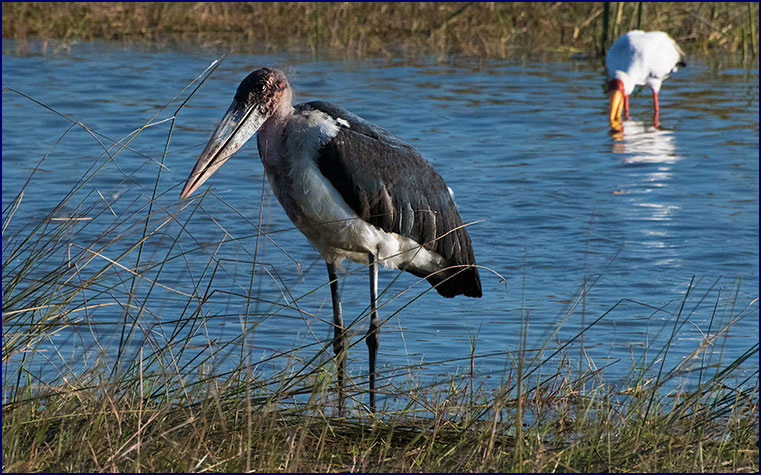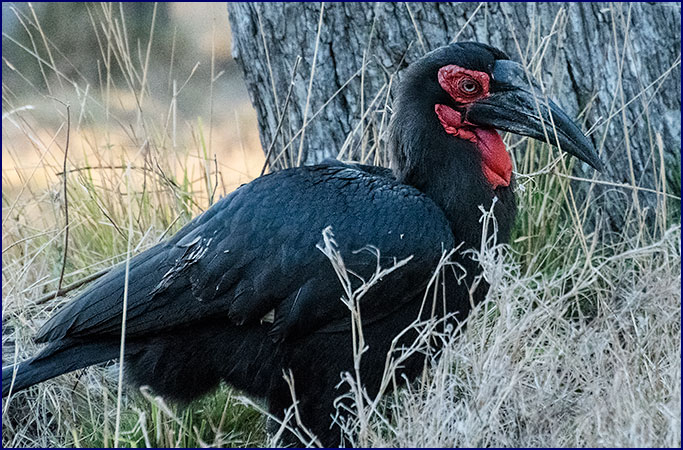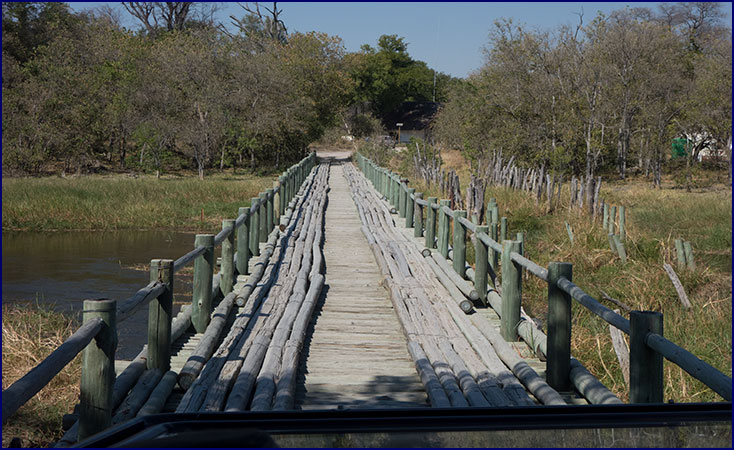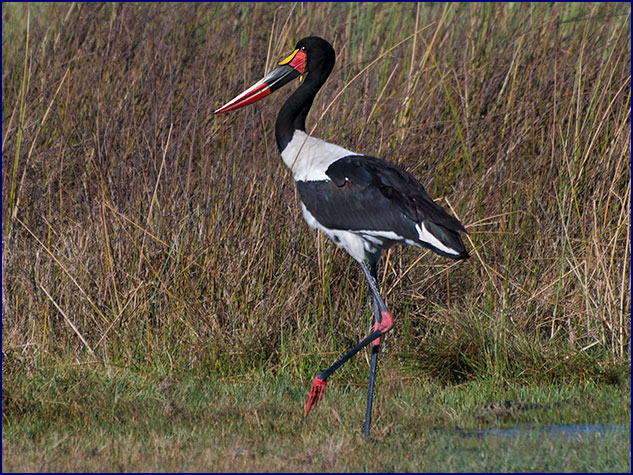|
July
26
It was moving day. We packed up
and set out, luggage trailer in tow, leaving Phillimon, Parker and
Pula to move camp. We left with some regret; we would miss our
secluded never-before-used campsite!
A small herd of impala stood with
their coats puffed up against the cold, while a brown snake eagle
looked down at them from a tree. We watched the sun come up; dead
trees were silhouetted against the fiery sky with twisted branches
reaching up like grasping hands. Pastel shades of dawn were
reflected in the floodwaters of the Delta.
Gee was very adept at interpreting the spoor; he pointed
out fresh hyena tracks on top of the tire marks in the sandy road,
and then lion prints overtop of those. He showed us petite baby
elephant tracks superimposed over its mother’s huge ones, and
also the tiny footprints of a mongoose.
We stopped by the hyena den. The
mother hyena was lying in the entrance; we could just see the top
of her head and ears poking up out of the hole. We waited, hoping
she would come out. A whole flock of arrow-marked babblers flitted
through the trees, several of them pecking in the dirt around the
den. The morning sun highlighted the golden curlicue grasses.
The hyena poked her head up a little more, gazing at us
with alert eyes. She must have babies in there; maybe they would
come out. Hoping to draw her out of the den Gee made a loud
bleating noise, mimicking a wounded buffalo calf being caught by a
lion - but the mother hyena was too smart to fall for that old
trick.
We left the den and headed out across the bushveld.
Referring to Gee’s promise to show us the toothbrush tree, Patty
said, “Gee, we all need to brush our teeth.” Gee pulled off
the road near some shrubs, checked for lions, and invited us to
get out of the vehicle. We all waited for him to find the
appropriate bush and give us a sample to clean our teeth with, but
he just stood watching us as we milled around. Finally, looking
confused, he said “But nobody is brushing their teeth!”
I thought it must be a test; did
we remember what the bush looked like? I turned to a likely
looking shrub and asked if it was the right one. At that moment
Gee realized there had been a total miscommunication; he had
thought we had neglected to brush our teeth that morning and
wanted to do it now! We all laughed until our sides hurt,
especially Gee - he chuckled about it for the rest of the day.
A marabou stork stood perched high in a dead tree, and
another stood by the water. These
huge birds are black with white underparts and have a long beak, a
bare red head, and a neck that they can contract into their
shoulders until it seems to disappear. Some of them have a grotesque
bulbous red pouch that hangs down from their throat and can be
inflated with air when courting. They are amazingly unattractive.
Rob remembered them having been called the undertaker
bird when he
visited Tanzania years ago, and the name seemed fitting.
|

Marabou
stork
|
A throwback from the past, some safari companies still
focus on seeing the Big Five:
the elephant, African buffalo, lion, leopard and rhino – those
were the animals most likely to kill you while big game hunting.
But the marabou stork is deservedly considered one of the Ugly
Five, along with hyenas, warthogs, wildebeest and vultures.
There were fewer animals out this
morning. We saw impala of course – they are always around; we
noticed one with an injured ear that drooped straight down.
Several kudus dashed through the brush, and then stopped and gazed
at us curiously. Gee pointed out leopard tracks in the road, both
coming and going. We followed the most recent spoor for a long
way, looking, stopping often to listen for alarm calls.
A
light-colored giraffe was moving through the trees at the edge of
a meadow, her pale coat glowing in the morning sun. A baby was
following behind her; he still had his umbilical cord, which Gee
said showed he was less than three weeks old. Several pelicans
sailed overhead. Gee pointed out a tiny bru-bru bird, which makes
a sound like a telephone.
It was mid-morning when Gee took a shortcut through the
brush, maneuvering the Landcruiser through the trees with the
luggage trailer bumping along behind. We came out near the river,
following lion tracks down a little-used track. As we paused, we
saw a lone lioness moving through the tall yellow grass toward us.
She walked straight to the Landcruiser. Gee said softly “be
quiet, don’t move.” She looked up at us briefly and walked
right by us, literally close enough to touch, squeezing between
the vehicle and the bushes beside the road. Gee started the
engine for a moment, causing the lioness to swerve away slightly -
he said later he was worried someone might panic that she was so
close. She stopped in the road and looked back at us over her
shoulder briefly. She was graceful, majestic power. She turned and
walked on.
We turned around and followed the lioness down to the
river. As we came out on the open floodplain, we drove around and
got ahead of her several times, then watched as she walked
sedately past us. She was noticeably pregnant; Gee estimated that
she was about two months along (the gestation period for lions is
3 ˝ months). He said she is part of the Machaba
Pride.
She was hunting, looking from side
to side and gazing intently into the distance – lions have
excellent eyesight. She stopped several times along the river,
almost as if posing for us, and then sat down on a termite mound.
After a while she moved back into the brush, and we left her to
her hunt. Getting to watch this beautiful huntress at work was a
special encounter.
A herd of about a dozen zebras lounged in the shade. About
half of them were lying down; they got hurriedly to their feet as
we approached and walked away, predictably showing us their
striped rumps. Four ground hornbills walked down the road in front
of us; these are really interesting birds, but they could be
runners-up for the Ugly Five list.
|

Ground hornbill
|
We crossed a rickety bridge made from poles, barely wider
than our wheelbase, and before long came to Khwai village. There
were a number of small round thatched houses called rondavels,
with some modern stucco buildings among them. The village was
quite spread out and very quiet – just a few people walking by
the road or standing near the houses. One woman was doing her
laundry in a water bucket, and a small boy waved to us as we
passed. Gee stopped by a safari office to return the rifle he had
carried when we went walking.
There were corrals with tall
fences made from tree trunks and branches, and occasionally barbed
wire; the fences were designed to keep animals out
more than in. Several rondavels were constructed from coke bottles
plastered together with mud-based cement. A smallish cinderblock
building had Khwai Shopping
Center painted on it in large irregular letters, but it
appeared to be abandoned.
As we left the village we crossed the Bridge over the River
Khwai. On our last trip Gee had temporarily convinced us that it
was the one from the famous movie (until we realized it was the
wrong continent); I had remembered that when Gee was telling us
that rock was a hippo back in Savuti!
|

Bridge over the River Khwai
|
We studied the large maps at the Khwai/Moremi gate, and
then had our tea under a tree nearby. Gee told us a little about
the history of the village, and about the Bushmen, or San people,
who lived in the Kalahari Desert. They lived off the land, hunting
and gathering, but when the parks were formed hunting was
outlawed. The government gave them cows to compensate, but the
Bushmen sold them. Gee told us about his farm; the island is 11
hectares (about 27 acres). He grows watermelons and maize, as well
as some other crops. We had several cups of tea before we moved
on; by the time we drove past the Khwai airstrip we had to stop to
check the tires.
We drove along a flooded plain,
stopping near a small round island which had formed around a large
termite hill; it had a scrubby tree growing out of it. On the tiny
island there were yellow billed storks, reed cormorants, sacred
ibis, spoonbills, a water thick knee, a grey heron, a little egret
and a pied kingfisher.
We followed the track along the
edge of the open plain. It was dotted with large termite hills;
Gee said many of the islands in the Delta started out from termite
mounds. Impala and zebras quietly grazed, and there were warthogs
everywhere. Still no buffalo though; we told Gee that we figured
they were imaginary.
Gee stopped the vehicle; he had found a toothbrush tree. A
vervet monkey watched him from a low branch as he pulled up roots
from a sapling. Gee gave us each a piece of the toothbrush tree
root to chew; at first it tasted like dirt, but once the bark was
off it had a slightly tannin taste and a pleasing texture, and it
made our teeth feel clean. We all brushed and spit - it was not a
pretty sight, but our teeth felt great afterwards!
We passed a family of warthogs, comically walking on their
knees to make it easier for their remarkable snouts to reach the
grass. A hippo was out of the water, grazing with a row of
oxpeckers sitting on his back. A red lechwe buck cantered across
the marsh, his distinctive downhill lope surprisingly graceful.
Two tsessebes wandered across the plain; Gee told us they are the
fastest of the antelopes, and can run up to 90 km per hour. They
often run around for exercise, even during the hot part of the
day.
We skirted the edge of a vast
plain; Gee said the current high water levels meant we had to go
along the edge of the forest instead of across the plain as we had
on the previous trip. An elephant was taking a mud bath in a
marshy spot. He would suck up muddy water in his trunk and spray
it over his shoulder onto his back. An adult saddle-billed stork
stood in the marsh; these tall birds have a large orange and black
striped bill, orange elbows and feet, and bright yellow eyes.
|

Saddle-billed stork
|
We came to an especially deep water crossing, and Gee hesitated.
“I think we can make it,” he said, but when he drove into the
water, the wheels went into a deep rut and we got stuck.
Tara and I got out of the Landcruiser to help, gathering wood to
put under the tires while Gee jacked up the vehicle. Taking off my
shoes and socks and stepping down into the cool water with the mud
oozing between my toes brought back memories of rescuing the Dutch
family in 2015. They had gotten stuck deep in the Delta in a
self-drive camper with no guide, and had been out there for five
days by the time we found them!
Gee jacked up the most deeply submerged rear tire and we
wedged logs and branches under it, and then we repeated the
process on other side. He tried to drive out, but it was too deep
and we were still stuck. Gather more branches, jack the tires up
again – we went through the whole procedure three times. Others
in our group got out to help, probably giving Gee more anxiety
than assistance as he tried to make sure we didn’t wander off
and get eaten by a lion. The whole thing was inconvenient but not
stressful; the guides get stuck often enough, and they know how to
get unstuck. Still, we weren’t sorry when another guide in a
safari vehicle with some German tourists came by and pulled us out
– though by that time we had the vehicle almost freed.
We were running quite late after getting stuck; it was four
o'clock by the time we arrived at our lunch spot, the Dombo Hippo
Pools, and we were quite hungry. Gee said we would need to eat
quickly and move on, as the park gate would be closed in two and a
half hours. I asked him how long it would take to get to camp -
two and a half hours, he answered. No time to linger. Looking out
over the lagoon while we ate, we could see white-faced ducks and
Egyptian geese dabbling in the shallows and a few hippos gliding
through the water. By 4:30 we were back on the road.
Gee drove like the wind, but we
still paused for a look whenever we came across something
interesting. An African hawk eagle perched in a dead tree; Gee
said it was a ‘true eagle.’ We learned that true eagles have
feathered legs, while hawks and snake eagles do not. We drove past
the Moremi airstrip, with its small canvas shed marked VIP
lounge. We had flown out of here on our last trip, and the
elephants had all come out on the airstrip to say goodbye. Looking
around now, we saw to our amazement that the elephants were still
there.
We arrived at our new camp, barely making the 6:30 p.m.
deadline. The crescent moon hung in the sky, noticeably bigger
now. Our tents were laid out in a grove of large trees, not far
from where we had camped in 2015. There was water nearby, and we
could hear the deep laughing call of the hippos. Tired but happy,
we sat around the campfire and discussed the events of the day.
Gee was still chuckling, “We need to brush our teeth . . .”
|